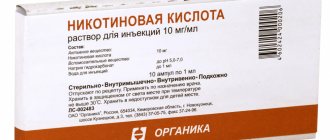Pangamic acid was first isolated from apricot kernels in the 20th century. Later it was discovered in cereal crops. Subsequently, the organic substance was given the name vitamin B15. The therapeutic effect of the combination of dimethylglycine with gluconic acid is still disputed by analysts in many countries and the tangible medicinal properties are not recognized. Scientists have found that the lack of ether has nothing to do with human metabolism, but experiments conducted in the USSR on rabbits indicate a positive effect of the substance on a living organism.
Biological role of vitamin B15
The functions of vitamin B15 make it a very valuable component for maintaining human health. Pangamic acid:
• Prevents excess accumulation of fat in the liver, prevents the development of diseases of this organ.
• Reduces a person’s tendency to become overweight • Participates in the formation of DNA and RNA, that is, the genetic material of cells • Important for the renewal of tissues, cells and their individual components • Participates in the production of phospholipids that protect blood vessels from atherosclerosis • Reduces the content of bad cholesterol in the blood • Participates in redox reactions, improves tissue respiration • Enhances the production of various adrenal hormones • Increases performance and endurance, relieves fatigue • Helps cleanse the body • Improves heart function • Strengthens the immune system • Reduces the harmful effects of drugs on the body • Exhibits some anabolic effect, promotes muscle growth with regular exercise • Has an anti-inflammatory effect • Helps normalize blood pressure.
Interaction with other substances
Vitamin B15 is a water-soluble compound that is easily destroyed by exposure to high temperatures and daylight. Briefly processing foods (for 5-7 minutes) over low heat under a tightly closed lid will help prevent nutrient loss.
Compatibility of vitamin B15 and other substances
- Calcium pangamate neutralizes the aggressive effects of toxic chlorine-containing substances, which, when inhaled, affect the mucous membranes of internal organs.
- Vitamin B15 reduces the severity of side effects that occur after the use of tetracycline antibiotics, excessive doses of aspirin and sulfonamide drugs.
- The simultaneous intake of calcium ascorbate (organic vitamin C) and pangamic acid leads to an increase in the antioxidant properties of both substances.
- Vitamin B15 potentiates choline synthesis.
- Pangamic acid enhances the pharmacological properties of beta-carotene, tocopherol and cyanocobalamin.
- The vitamin-like compound improves the absorption of corticosteroid and anti-tuberculosis drugs.
- Caffeine, nicotine, and alcohol reduce the concentration of the nutrient in the blood.
- Vitamin B17 enhances the oncoprotective properties of pangamic acid.
It is important to take these interactions into account when drawing up complex therapy for treating diseases.
Signs of vitamin B15 deficiency
Since small doses of vitamin B15 are produced in the body, it is rare to see a deficiency of pangamic acid. However, it is possible. Most often, a deficiency state manifests itself with nonspecific symptoms, which people for months and years attribute to fatigue, overwork, age and a general weakened level of health. Among the main symptoms of deficiency are a feeling of fatigue, cardiac problems, poor skin condition, early appearance of signs of aging, bad mood, irritability, and disturbances in hormone production.
Indications for additional use
Vitamin B15 has a positive effect after long-term use of antibiotics and tuberculosis medications. Scientists have found that, like thiamine, calcium pangamate:
- reduces blood pressure;
- increases oxygen levels.
For this reason, the drug is prescribed for the treatment of lung diseases and other cases of oxygen deprivation. Vitamin B15 is often prescribed to athletes. It is used: for:
- treatment of respiratory organs for acute respiratory viral infections;
- detoxification;
- prevention of neuroses;
- removal of toxins.
There is an opinion that due to the saturation of the body with oxygen, in case of malignant neoplasms, dietary supplements help suppress cancer cells, and the formation of metastases slows down. This property has not been scientifically proven, and the product only supports the patient’s immunity.
Vitamin B. Hypervitaminosis
Symptoms
Taking into account the above features of the metabolism of B vitamins, one could assume a statistical predominance of one-time, acute overdoses caused by more or less random intake of concentrated drugs in large volumes.
However, if we add psychological (self-prescribed treatment and prevention) and iatrogenic (inadequate dosages of vitamin therapy prescribed by a doctor) to the biochemical nuances, a significant proportion of chronic hypervitaminosis B also becomes clear. The vast majority of such cases are overdoses of B1, B3, B5, B6, B9 and B12. The most typical and common symptoms are increased excitability, emotional instability, tachycardia, headaches, nausea, redness of the skin, dyssomnia (certain sleep disorders).
Vitamin B1 (thiamine) in excess doses can cause anaphylactic shock, skin reactions such as urticaria and increased photosensitivity, kidney and liver dysfunction.
Vitamin B3 (niacin, vitamin PP, nicotinic acid) in overdose causes, in addition to the above-mentioned symptom complex, severe dyspepsia, dizziness, itching and paresthesia (false tactile sensations), muscle pain, cardiovascular disorders (high blood pressure in a standing position).
Acute hypervitaminosis B5 (pantothenic acid) can, among other things, cause dehydration.
Overdose of B6 (adermine, pyridoxine) – atactic phenomena in the form of impaired coordination of movements, confusion, convulsions, increased acidity of gastric secretions.
Hypervitaminosis B9 (folic acid) – cramps in the lower extremities, allergic reactions. In addition, in 2016 , the results of a study conducted by employees of the Johns Hopkins Institute (USA) on medical and statistical data for the period 1998-2013 were published. It has been shown that unreasonable and deliberately excessive consumption of folic acid and cobalt-containing vitamins B12 by pregnant women (and the importance of these vitamins during gestation is well known) increases the risk of autism in children by 2-3 times, especially if “hyperprophylaxis” occurred in the third trimester. In addition, B12 increases blood clotting and, accordingly, the risk of blood clots. In general, the results of the study make us think seriously and once again raise the question of the feasibility, the need for the most careful monitoring, taking into account all indications and contraindications for vitamin therapy and vitamin prophylaxis during pregnancy: in many cases, the optimal level of con in the blood was exceeded by 15-17 or more times . The most severe complications of hypervitaminosis B include renal and liver failure, steatohepatosis, pulmonary edema, anaphylactic shock, exacerbation of gastroenterological and cardiac diseases.
It is interesting to note that the clinical picture of hypervitaminosis B is largely reminiscent or even repeats the symptoms of hypovitaminosis.
Daily norm
The exact amount for humans has not yet been determined. Analysts claim that 2 mg is a sufficient amount and increase it in the diet only during increased physical activity or according to medical recommendations.
Lack of vitamins causes various diseases. Even with a balanced diet, not all substances are absorbed. Some of them are washed out or destroyed. Alcohol, for example, kills all B vitamins. Pangamic acid is no exception. Doctors advise taking a set of vitamins that are compatible with each other.
Vitamin D deficiency
A lack of vitamin D in the body can lead to the development of:
- diseases of the cardiovascular system
- immunodeficiency, allergies, psoriasis, bronchial asthma, rheumatoid arthritis
- periodontal disease
- tumors of the large intestine, mammary glands, ovaries, prostate
- chronic fatigue, depression, insomnia
- decreased muscle strength leading to a risk of falls
- decreased motility and number of morphologically normal sperm (male factor infertility)
- risk factor for premature birth, fetopathies (less than 20 ng/ml)
Achieving a vitamin D level of 50 ng/ml (125 nmol/l) reduces the risk of developing:
| % | |
| Rakhita | 100 |
| Ostemalacia (softening of bone tissue) | 100 |
| Cancer in general | 75 |
| Breast cancer | 50 |
| Ovarian cancer | 25 |
| Colon cancer | 65 |
| Kidney cancer | 65 |
| Uterine cancer | 35 |
| Diabetes mellitus type 2 | 50 |
| Perelomov | 50 |
| Falls in women | 70 |
| Multiple sclerosis | 50 |
| Myocardial infarction | 50 |
| Vascular diseases | 80 |
| Preeclampsia | 50 |
| Caesarean section | 75 |
| Infertility | 70 |
Vitamin D is important during pregnancy.
Its deficiency is associated with the risk of developing gestational diabetes mellitus, premature birth, preeclampsia, and various intrauterine developmental defects.
There is not a single case of teratogenic (leading to the development of tumors) effect of vitamin D in the world.
General information and history of discovery
Pangamic acid (lat. Acidum pangamicum) in its pure form is an extremely unstable substance, therefore it is used only in the form of a salt - calcium pangamate (lat. Calcii pangamas).
The chemical formula of vitamin B 15 is C10H19NO8.
Systematic name: 6-(2-dimethylamino-acetoxy)-2,3,4,5-tetrahydroxy-hexanoic acid. The compound is an ester of dimethylglycine and gluconic acid.
The first discovery belongs to the Japanese scientist T. Tomiyama, who isolated the molecule from cow liver in 1950.
The name “pangamas”, derived from the Greek words “pan” - everywhere and “gami” - seed, was introduced into use after the presence of the substance in the bones and seeds of plants was established.
Why does the body need it?
B15 provides many benefits to the body. This is an important vitamin for detoxifying the body. It plays a huge role, namely:
Helps reduce LDL (low-density lipoprotein, commonly called “bad” cholesterol) levels. Enters into the process of oxygenation of organs, muscles, cells. Slows down cellular aging. Plays a vital role in liver and kidney metabolism. Neutralizes many toxic substances that are very bad for the body (for example, alcohol) because it accelerates their oxidation. This is why B15 is thought to be able to protect the liver from cirrhosis. Reduces glycogen consumption. Reduces the formation of lactic acid in muscles.
- B15 promotes the formation of certain amino acids such as methionine.
- It takes part in the oxidation of glucose during cellular respiration.
- It gently stimulates the endocrine and nervous systems, and also improves liver function.
Pangamic acid is often called the athlete's vitamin because:
- It allows you to increase the duration of physical training and the intensity of physical activity.
- It helps with recovery after exercise.
- He fights fatigue.
B15 may be beneficial for children with mental retardation. It also helps treat asthma, synthesize proteins and prolong the life of cells in the body.
Good to know: B 15 is essential for people with heart problems.
Physicochemical characteristics
Due to the lability of chemical bonds, studying the properties of pure pangamic acid is difficult: it is destroyed under the influence of ultraviolet rays and high temperatures, and dissolves in water.
To produce drugs that have an identical biological effect, calcium pangamate is used, the chemical formula of which is [ COO ~ - CHOH - CHOH - CHOH - CH0HCH2OCOCH2N(CH3)2 ] 2Ca2+ -H2O.
The substance is a white powder, insoluble in alcohol and organic solvents, having a melting point of 132-140°, stable in acidic environments and rapidly decomposing in alkaline environments.
Instructions for use of calcium pangamate
Since the substance is quickly destroyed in the body, the drug is divided into several doses. The drug is taken orally, 1-2 tablets (50-100 mg) 3-4 times a day. The tablet should be swallowed whole with liquid. Although the vitamin can be taken with or without food, it is best taken between meals.
Daily doses:
- For adults: 100-300 mg.
- For children:
- up to 3 years - 50 mg;
- from 3 to 7 years - 100 mg;
- from 7 to 14 years - 150 mg.
Application of calcium pangamate.
Treatment is carried out in courses of 20-40 days, repeated after a 2-3 month break.
Metabolism
When taken orally as part of food or medications, Pangamic acid is absorbed quite quickly and easily from the intestines. After this, it is distributed to organs and tissues, where it is included in metabolic processes. Some of it ends up in the liver. Here it undergoes transformations with the formation of the amino acid Glycine and another metabolite of Sarcosine, which also has physiological activity. Vitamin B15 does not accumulate in the body; its excess is excreted unchanged by the intestines and kidneys.
Natural springs
Record holders for the content of pangamic acid or vitamin B15 are seeds and seeds of plants, nuts. The absorption of the substance from these products is the highest, since they contain fat-soluble vitamins A and E, which improve the absorption of pangamic acid.
Among products of animal origin, to enrich the diet with vitamins, we can recommend pork or beef liver, blood sausage. However, given the compound's thermolability, untreated plant sources are preferred.
The approximate content of vitamin B15 in food products is presented in the table:
| Product | Content per 100 g, mg |
| Sunflower seed, pumpkin | 0,2 |
| Nuts | 0,14 |
| Apricot kernels | 0,16 |
| Beef liver | 0,1 |
| Watermelon melon | 0,07 |
| Brown rice | 0,06 |
| Brewer's yeast | 0,05 |
Restrictions on use
The supplement is a good way to maintain physical activity, but people suffering from high blood pressure and glaucoma should not take additional B15. Pensioners are usually susceptible to diseases that increase intraocular pressure.
Children are prescribed with caution. Women are prohibited from taking a mineral supplement while breastfeeding, as the substance is mixed into milk. Pregnant women take any medications only as prescribed by the doctor, including vitamins.
What causes vitamin D deficiency?
Vitamin D deficiency in many Russian residents is due to:
- location in the northern temperate zone (above 42 degrees north latitude)
- limited exposure to the sun (office work, driving cars)
- eating meat from animals that have not been exposed to the sun (farm)
- use of sunscreens
- chronic diseases (obesity, intestinal pathology, taking a large number of medications)
You can determine the level of vitamin D in your body by taking the following test:
25-OH vitamin D (25-hydroxycalciferol) (amount)





